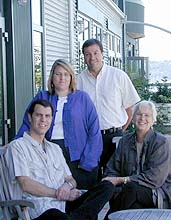September 5, 2001
Growing Vine Street takes root at 81 Vine
Special to the Journal
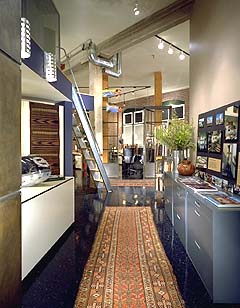
The Geise office is one of two architecture offices at 81 Vine. Arts and design are well represented among the owners and tenants at the address. |
It’s a familiar site in Rome: an old low-rise masonry building with a pop-up addition set back from the top. But 81 Vine is in Belltown, and the old brick building was a 1914 factory.
Although the penthouse is only a year old, there is already a small forest growing from the terrace beside it. Even the downspout is sprouting branches. This is ecotopia, all right, with European references. The renovation at 81 Vine is a homegrown Seattle vision of an urban future.
The mixed-use storefront, office and condominium designed by Geise Architects is a two-stage project. It began with the gutting and interior renovation of the four-story brick factory. The units inside the simple but dignified historic base building were first to be completed, opening in 1995. The top two floors rented as apartments, and among the tenants was amazon.com CEO Jeff Bezos. All 19 residential units were put up for sale in 1999 after the completion of the two-story penthouse addition.
| 81 Vine |
|
Owner:
Growing Vine LLC Architect: Geise Architects Project type: Mixed-use, renovation Project size: 42,800 square feet (30,000 square feet in base building and 12,800 square feet in penthouse addition) Completion date: Spring of 2000 Construction cost: $4.6 million Structural engineer: Ratti Swenson Perbix (base building) Skilling Ward Magnusson Barkshire (penthouse addition) Civil engineer: SvR Landscape architect: Peggy Gaynor Architectural artist (interior fixtures and details): Jonn Geise Environmental artist: Buster Simpson General contractor, base building: Pacific Components General contractor, penthouse addition: Peter Davis Builders |
| Jury comments: "One of the charms of Belltown is, or more appropriately was, its collection of quirky and strong industrial and commercial buildings. These structures have a comfortable pedestrian scale and interesting detail throughout, making the district a place in which people naturally want to live. 81 Vine Street captures Belltown's original spirit with wit and grace." "The respect that the new additions show toward the original factory building, the use of environmentally sensitive solutions and the integration of art and craft throughout illustrate what good urban design should be.” “This project is an overlooked gem in the fabric of the city. It is so good as to be invisible. It is an excellent adaptive reuse of an historic building, it includes a significant addition to an historic building which is so separate from the original as to not be connected, and it demonstrates a sensitivity to design in the detailing. This project should be recognized for its strength as a design solution without being a monumental design statement.” |
Each of the condominium units is as individual in size and shape as any neighborhood single-family house, all fitting like a puzzle into the existing shell. Since they came on the market, they have been among the few choices for buyers in Seattle looking for modern loft space in a historic building.
A masterwork of urban recycling, 81 Vine is also the heart of a bold and brave experiment in environmental stewardship: Growing Vine Street. The building now serves as a showcase for the concept, which involves artist-designed drainage elements, plantings and sidewalk improvements that would turn the length of Vine Street into a pedestrian oasis and destination. The campaign to implement Growing Vine Street is a wake-up call to the city’s sleeping Green Streets program.
At the center of 81Vine and Growing Vine Street stands a tall figure in Belltown, architect Carolyn Geise. With tenacious vision—and the day-to-day help of project architect Judy Tucker as well as development partner and son Matt Geise—she has combined a family real estate enterprise with community activism and progressive urban design.
It all started in the summer of 1992, when the Geises began walking around the old brick factory, dreaming of lofts. In partnership with several other family members, they bought the building that year and Carolyn and her firm began designing the renovation.
“All the big developers had stopped by then,” said Carolyn. “We didn’t know any better.”
Like a handful of other projects by local designer and developer teams in Seattle, 81 Vine began as a dream of live-and-work spaces for people with moderate incomes. But like others before and after the project, it just wouldn’t pencil out in the end. The hot construction market and the many demands of historic renovation left little room to maneuver.
In the end, time was on the side of 81 Vine.
By the time all 19 residential units of the project—including the penthouse—were put on the market in 1999, the economy was peaking, and Belltown was becoming a well-known destination as well as a rapidly growing neighborhood. The idiosyncrasies of its spaces, which include a renovated book bindery in the back with an alley entrance through the top, had proven to attract a small but affluent market. Carolyn Geise and the developer team are proud to have sold the units at a wide range of prices, from $200,000 to over $800,000. Since that time, several of them have resold to self-selected members of the community inside the building. The success of 81 Vine has shown that architecture can be more important than square footage.
“This building is full of subtle decisions that reinforce the building’s shape, forms and function,” said Carolyn Geise.
Ceilings inside the original building are 13 feet high. In the loft tradition, each is a flexible environment, not a cluster of rooms. The units have small kitchens along one of the walls and a bath and laundry tucked behind another. Loft living is not for everyone, said Tucker, and buyers tend to self select when they walk into the open-plan units and see the platforms that typically hold only a bed.
“They don’t ask, ‘Where is the bedroom?’” said Matt Geise.
The renovation began by consolidating the vertical circulation, centering the stairway and elevator on the length of the building at the back. The main entrance to the living units was moved from busy Western Avenue to Vine Street, just opposite the stair and elevator shaft. The move leaves a storefront entrance on Western, and provides for more quiet access to residents.
A new floor was introduced to divide the 17-foot high main floor bay, creating a new level for office and commercial space that opens out to Vine Street. The new floor extends into the corner restaurant on Western, opening to street-level tables and bar below. Parking for 14 cars is tucked into the hill below the commercial and office space, including two stalls on top of the “bindery” unit.
The tall ceilings in these residential floors inside the original building would not quite accommodate a second floor. Just over five feet in height, the “lofts” tucked into the condominium units must be formally classified as storage space. Many are used as sleeping areas, however, according to the discretion and height of the owner.
Because the long side of the living units lies against the exterior wall, every unit captures a number of the tall windows on each side of 81 Vine. Even the minimum square footage in the studio loft units are offset by high ceilings and expansive views of the Belltown neighbors, the waterfront and the bay.
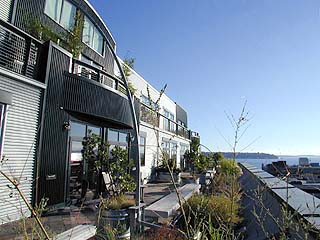
Most units are aligned with the length of the outer walls, affording better natural light and views for residents. |
The original structure is brick and heavy timber on a concrete base. But from the beginning of the project, the owners planned to build a penthouse addition at 81Vine. The seismic upgrade of the original building helped to provide the structural base for the addition. This was all the more necessary because code required a more fire resistant structure in the addition than in most wood-frame structures. Thanks to two layers of gypsum board between frame and metal siding, penthouse residents enjoy restful quiet above the city streets.
Geise and her company, which included associate principal Judy Tucker, were well aware of the problems with leaky walls and windows that plagued several multi-family buildings in Belltown, and determined to do everything right the first time. For instance, their research turned up a German-made flashing system for windows that is as impermeable as a bathtub, according to Tucker. And so it goes, with polymeric membrane roofing in the vaulted penthouse roofs and exterior metal siding set into “hat channels” to provide ventilation.
The shape of the two-story penthouse addition is dominated by two barrel vaults, one pointing to a view of the bay and the other at a right angle in the middle of the penthouse. The vaults, which terminate in arched windows, accommodate loft spaces inside.
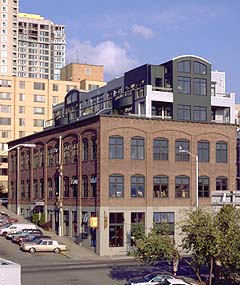
Located at the intersection of Western and Vine, 81 Vine preserves a piece of Belltown’s scattered architectural legacy. |
The metal-clad penthouse addition is pulled back from the corner of the building, creating a generous terrace at the first level and accommodating the view corridor along Vine Street. The second level is set back again, with a five-foot walkway all around and bowed-out balconies at the ends of the vaults. Five of the seven condominiums inside the penthouse open onto the terrace. The other two units have small decks facing south, with views of the city.
Penthouse residents are full participants in “Growing Vine Street.” This slowly developing urban experiment began when Geise, as a partner and architect for 81 Vine, found that Vine Street was designated by the city of Seattle as a “Green Street.” When her inquiries yielded little information about what that meant, she and her partners began to invent their own answers.
They were inspired by the Belltown P-Patch, an art-encrusted landmark and community garden nearby. The community was enrolled in grant writing and design charrettes. With the help of a larger design team guided by Greg Waddell of Carlson Architects, Growing Vine Street has become a vision of green and community open space in the city.
It all starts on the roof and in the streets, with runoff channeled into a system of sculptural cisterns. The plan would divert water from combined sewers and overloaded sewage treatment plants, gradually filtering it in a biofiltration swale running the length of the street. Leading down to the bay from Western Avenue, the swale would fan out into a series of “cistern” steps punctuated by pools and runnels and providing a pedestrian destination.
The award-winning concept has won support from the Seattle’s Department of Neighborhoods and endorsements from a long list of civic groups and professional organizations. But the realization of this most visionary green street has been slowed by jurisdictional and technical issues among city departments. In the meantime, Growing Vine Street has taken root at 81 Vine.
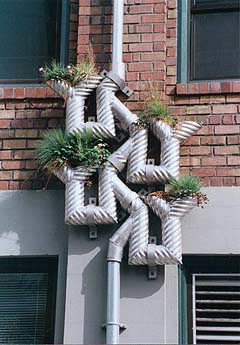
Buster Simpson’s branching downspouts, made of corrugated aluminum pipe, are designed to be “vertical planters.” |
The terrace at the first level of the penthouse is built up above a crawl space in order to look out over an existing parapet wall around the top of the original building. It looks over and through one of the first elements of Growing Vine Street, an artificial wetland on the rooftop designed by artists Buster Simpson and Peggy Gaynor. Inside the “moat” created by the gap between the raised terrace and the parapet lies a large galvanized, corrugated culvert pipe—artfully cut away to create a planter. Inside, a marshy combination of willows, blueberries, Oregon grape and other native plantings provide a garden view while working hard to filter runoff before it passes on to the street.
The planter is just one of the many stops made by rainwater at 81 Vine. It is funneled into the planter from the roof in two “bow-trussed” downspouts that arc over the terrace beside the penthouse.
The downspout that takes the partially filtered runoff down to the street from the terrace, also designed by Simpson, is actually a “vertical planter” which will eventually sprout grasses and other greenery from it’s upturned branches.
“We’re really the headlands of Vine Street,” said Tucker.
Together, the pipes, gutters, holding basins and planters at 81 Vine serve as a demonstration project for the Growing Vine Street concept.
| Growing Vine Street team | |
In addition to over $50,000 in support from community fund raising, the project is partially funded by $60,000 in grants from King County and $250,000 in grants from the Seattle Department of Neighborhoods. |
“The challenge is to make the city work ecologically,” said Simpson, “and come into some kind of partnership with photosynthesis and the biological systems.”
He is now designing an even more prominent piece, a sculptural metal cistern to catch runoff at the northeastern corner of 81 Vine. Since it can’t block the sidewalk, the cistern will literally reach over to the downspout, beckoning with pipe fingers spread out to resemble a large hand. Along with the cistern, improvements at the street level of 81 Vine—now in the permitting stage—include a series of marshy pools designed by Peggy Gaynor that will further filter runoff.
As 81 Vine continues to take shape, so does Growing Vine Street. A section called the “Cistern Steps,” which will run past the P-Patch on the half block of Vine between Elliot Avenue and the uphill alley, is in the final phases of review for a permit to build. The developer of the block diagonally across from the P-Patch, Intracorp, found springwater in its excavation and will channel that to the steps along with roof runoff collected in a cistern. Intracorp will also implement other elements of Growing Vine Street. After a decade of designing and promoting the concept, this is growth indeed.
“This is 20-year project,” said Simpson.
The Project of the Month for September, 81 Vine, was selected with the assistance of architects Jennie Sue Brown, Chris Carlson, Mel Streeter and developer Michael Trower. For more information about submitting projects for possible feature articles, contact Peter Sackett at AIA Seattle, (206) 448-4938, or psackett@aiaseattle.org.
Clair Enlow can be reached by e-mail at clair@clairenlow.com.
Previous columns:
- A new model for affordable housing, 08-01-2001
- Swimming in good architecture, 07-05-2001
- High-tech medicine, spiritual space, 05-02-2001
- Masonry memories: Rehab captures raw splendor, 04-04-2001
- Stepping out of the box, 03-07-2001
- Project of the Month: Callison stitches a new base onto Space Needle, 02-07-2001
- DJC Project of the Month: Mithun's westward movement, 01-03-2001
- Project of the Month: Research heaven at Harborview, 12-06-2000

